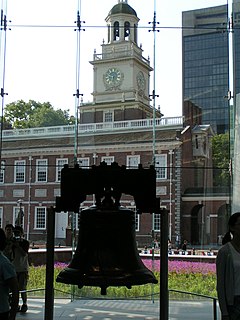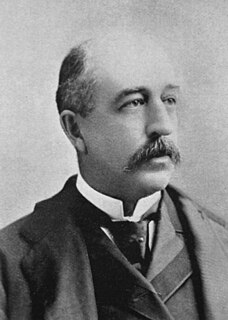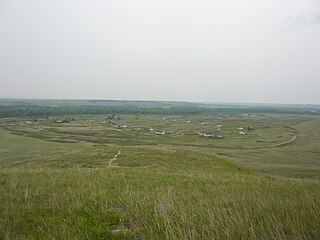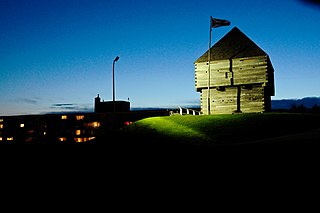
The National Register of Historic Places (NRHP) is the United States federal government's official list of districts, sites, buildings, structures, and objects deemed worthy of preservation for their historical significance. A property listed in the National Register, or located within a National Register Historic District, may qualify for tax incentives derived from the total value of expenses incurred preserving the property.
A historic house generally meets several criteria before being listed by an official body as "historic." Generally the building is at least a certain age, depending on the rules for the individual list. A second factor is that the building be in recognizably the same form as when it became historic. Third is a requirement that either an event of historical importance happened at the site, or that a person of historical significance was associated with the site, or that the building itself is important for its architecture or interior.

National Historic Site (NHS) is a designation for an officially recognized area of national historic significance in the United States. An NHS usually contains a single historical feature directly associated with its subject. A related but separate designation, the National Historical Park (NHP), is an area that generally extends beyond single properties or buildings, and its resources include a mix of historic and sometimes significant natural features.

Sulphur Mountain Cosmic Ray Station, a National Historic Site of Canada found atop Sulphur Mountain in Banff National Park, commemorates Canada's participation in the International Geophysical Year, during 1957 to 1958. Canada constructed nine sites to study cosmic rays, but this site in particular was the most important due to its higher elevation. The National Research Council constructed a laboratory at the site in the winter of 1956-57. The building was not visible from the Banff townsite as a condition of its construction.

Pictou Academy (PA), founded in 1816 by Dr. Thomas McCulloch, is a secondary school in Pictou, Nova Scotia. Prior to the twentieth century, it was a liberal nonsectarian college, a grammar school, an academy and then a secondary school. Pictou Academy's current principal is James Ryan. The Pictou Academy Educational Foundation provides additional funds to the school. The student council executives for the 2015-16 school year are Josh Young, Co-President, Aran MacDonald, Co-President, and Clare MacDonald, Vice President.

Historic site or Heritage site is an official location where pieces of political, military, cultural, or social history have been preserved due to their cultural heritage value. Historic sites are usually protected by law, and many have been recognized with the official national historic site status. A historic site may be any building, landscape, site or structure that is of local, regional, or national significance.

The Cave and Basin National Historic Site of Canada is located in the town of Banff, Alberta, within the Canadian Rocky Mountains, at the site of natural thermal mineral springs around which Canada's first national park, Banff National Park, was established.

Central Alberta is a region located in the Canadian province of Alberta.

The Royal Jubilee Hospital is a 500-bed general hospital in Victoria, British Columbia, Canada located about 3 km (1.9 mi) east of the city centre, in the Jubilee neighbourhood.

Gitanyow is an Indian reserve community of the Gitxsan people, located on the Kitwanga River 8 km south of Kitwancool Lake, at the confluence of Kitwancool Creek. The community is located on Gitanyow Indian Reserve No. 1.

Nurses in Canada practise in a wide variety of settings, with various levels of training and experience. They provide evidence-based care and educate their patients about health and disease.

Frederick Montizambert, was a Canadian physician and civil servant. He was the first Director General of Public Health in Canada.

Events of National Historic Significance are events that have been designated by Canada's Minister of the Environment, on the advice of the national Historic Sites and Monuments Board, as being defining actions, episodes, movements or experiences in Canadian history. To be designated, an event must have occurred at least 40 years previous; events that continue into the more recent past are evaluated on the basis of what occurred at least 40 years ago. As of October 2018, there were 485 designated Events of National Historic Significance.

Blackfoot Crossing Historical Park is a complex of historic sites on the Siksika 146 Indian reserve in Alberta, Canada. This crossing of the Bow River was traditionally a bison-hunting and gathering place for the Siksika people and their allies in the Blackfoot Confederacy. Nearby are the remains of an ancient earthlodge village, believed to have been built by people from the Upper Mississippi valley in what is now the United States. It is unique in being an example of a permanent village on the plains: an area associated with nomadic hunting. The crossing became an important place in Canadian history when Treaty 7 was signed here between the native nations of what is now southern Alberta and the Canadian government on behalf of the Crown in 1877. It was also here that Crowfoot, chief of the Siksika, is believed to have died and been buried. As well, Poundmaker, a chief of the Cree who had been ceremonially adopted by Crowfoot in order to create peace between the Blackfoot and the Cree, was also buried here until being moved in 1967. In 1925 the traditional gathering site and the treaty signing site were declared National Historic Sites of Canada by the federal government's Historic Sites and Monuments Board of Canada. In 1972, the earthlodge village was also declared a national historic site.

Victoria City Hall is the city hall for Victoria, British Columbia, Canada. It is located at the corner of Douglas Street and Pandora Avenue in Downtown Victoria. It is home to the Victoria City Council. It was completed in 1890. It was designated a National Historic Site of Canada in 1977 and was also designated as a heritage site by the municipality in 1979.

The Pemberton Memorial Operating Room is a National Historic Site of Canada, the first operating room of the Royal Jubilee Hospital in Victoria, British Columbia. It established the Royal Jubilee Hospital as the leading surgical hospital in the province.
















